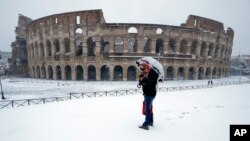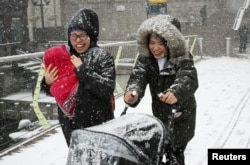Temperatures in the Arctic in recent days have surged above the freezing point, raising fears that climate change is affecting the planet’s atmospheric system far faster than predicted.
The Norwegian archipelago of Svalbard sits high above the Arctic Circle. It is still late winter, and the sun won’t rise above the horizon for another three weeks, and yet the ice is melting. Waves lap the shoreline of fjords that just a few years ago would have been frozen solid. Snowmobiles lie trapped in muddy meltwater.
In the past 30 days, temperatures in Svalbard have soared 10 degrees Celsius above average, and weather station data suggests it’s even gone above freezing at the North Pole.
WATCH: Huge Arctic Temperature Spike May Be Linked to Europe Cold Snap
“We’ve seen what are called these winter warming events before. But what we know is they’re becoming more common, and they’re lasting longer, and they’re becoming more intense as well,” NASA climatologist Alek Petty told VOA.
Warm Arctic, cold Europe
Warm, cyclonic low-pressure systems are being drawn into the Arctic. At the same time, winter sea ice cover is at its lowest since records began. Scientists say the arctic region is warming twice as fast as the global average.
“The ocean stores huge amounts of heat, and as soon as you remove that sea ice then this heat can essentially be transferred into the atmosphere, and so we think these lows are now gaining some additional heat,” professor G.W.K. Moore of the University of Toronto said.
The warm arctic weather coincides with an unusually severe cold snap across Europe. Temperatures in Germany have dipped to minus 27 degrees Celsius, while in Ukraine the severe weather has caused blackouts. Snow has covered Rome’s Colosseum and the palm-fringed shores of the Bay of Naples.
A theory known as “warm Arctic, cold continents” suggests that the winds that circulate around the Arctic and normally keep it cold, known as the polar vortex, become unstable. Warm air is taken in and cold air expelled into lower latitudes.
“Is this loss of sea ice and this rapid warming we’re seeing in the Arctic making the likelihood of these cold snaps in Europe, say, more common? And that’s the more contentious issue here. Unfortunately, we just don’t have many years of data here,” NASA’s Petty said.
Jet stream perturbed
Thirty kilometers up, there has also been what’s called stratospheric sudden warming, which is having a big influence on the weather, Moore said.
“Essentially, it perturbs the jet stream, which is this core of high winds that go around the Earth. And that perturbed jet stream is now leading to Europe being under the influence on easterly winds from Siberia,” he said.
Short term, the plunging temperatures have caused travel chaos in Europe, with several airports closed, and rail lines and roads blocked.
Longer term, the impact — though not yet fully understood — could be far more profound for the whole planet.










